Abstract
Structured light fields carrying orbital angular momentum (OAM) have been widely studied, and a variety of applications have been found. The exploration of the generation of the structured light beams with higher purity, order, and efficiency has become an inevitable trend. In early years, structured light beams are normally generated with the extra-cavity methods, as it is simpler in principle. However, the intra-cavity generation of the structured light has a better beam purity and higher light conversion efficiency. Here, the current advance in the production of structured light directly from lasers based on spatial light modulators (SLMs), metasurfaces, and microrings is reviewed.
1. Introduction
Structured light is a type of electromagnetic wave which has a specially structured phase and amplitude distribution. Because of the interesting properties of varying phase, polarization, and intensity profiles, structured light fields have attracted more and more attentions [1,2,3]. Airy beams, vector beams, SU(2) beams, and Bessel beams are all structured light fields [4]. We concentrated mostly on the vortex beams with high OAM values or complex intensity distributions in this review. Scholars in different fields have studied the application of the structured light fields, which is mainly reflected in the following aspects: (1) Optical micromanipulation: Optical tweezers are scientific instruments that use vortex structured light beams to hold and move microscopic or sub-microscopic particles non-invasively [5,6]. Meanwhile, some optical tweezers can be utilized as a micro-rotor or optical spanner, which are capable of particle rotation [7]. These studies have played a key role in life science and other fields [8]. (2) Optical communication: OAM beams have a more complex structure in space. They carry different topological charges which are orthogonal to each other [9,10,11], which provide a promising prospect for the expansion of the communication system [12]. (3) Imaging: Structured light can be employed in super-resolution imaging to boost the resolution of microscope systems beyond that of the imaging optics, such as confocal microscopes [13], two-photon microscopes [14], second-harmonic microscopes [15], third-harmonic microscopes [16], and dark field imaging [17,18]. (4) Processing: Vortex beams are generally utilized to manufacture chiral structures in metals. With a circularly polarized optical vortex incident on the metal, chiral nanostructures can be produced by transferring the helicity in vortex light to nanostructures [19,20]. (5) Measurement: The rotational Doppler shift appeared while vortex beams were vertically indenting on the rotating object, which has been broadly researched in many cases, such as the detection of apparatus vibrations [21], measurement of angular velocity, and acceleration of non-contact objects [22,23,24].
Consequently, it is critical to develop the technology of generating and tailoring structured light fields to expand applications further. There are many ways to realize this, and this can further promote the development of structured laser system to a more compact direction. In general, the generation of structured light fields can be grossly divided into two groups: One is the extra-cavity methods, which prevailingly modulate the light fields outside the resonator; the other is intra-cavity methods, which mainly generate structured light fields actively by inserting different modulation components inside the resonator [25]. This review mainly focuses on the structured light lasers employing intra-cavity phase and amplitude modulation with spatial light modulators, metasurfaces, and microrings.
2. Extra-Cavity Methods and Intra-Cavity Methods
In extra-cavity methods, optical elements like spiral phase plate, fork grating, SLM (Spatial light modulator), DMD (Digital micromirror device), and metasurface are typically employed to transform the incident Gaussian beams into structured light beams [26,27], as shown in Figure 1. The extra-cavity methods can be considered as pattern converters as well. Although it is convenient to generate structured light beams by using various external-cavity optical elements, obvious limitations still remain. For example, optical alignment error outside the cavity will lead to unstable propagation of structural light beams. Especially for structured beams with topological charges greater than 1, vortex splitting occurs in structured beams [28]. In addition, due to the surface defects and discontinuity of the phase or polarization of the optical element, the scattered light appears inevitably in the propagation of Gaussian beams. This part of the scattered light will interfere with the structured light beams. Moreover, the structured light beams generated in external cavity lasers generally have low purity, and it is hard to obtain the structured light with purity better than 90% [29].
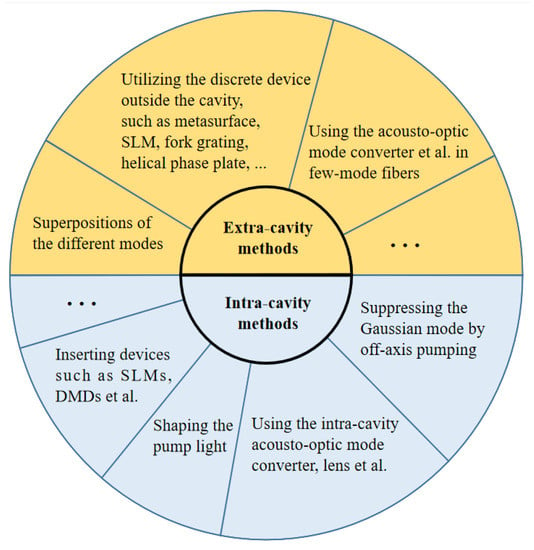
Figure 1.
The generation of the structured light with intra- and extra-cavity methods.
Compared with the structured light beams generated with extra-cavity methods, the approaches of intra-cavity generation make the system more compact and higher in efficiency. Furthermore, the structured laser beams generally have better beam purity. In 2017, Leticia et al. presented an fibre laser using an acousto-optic mode converter that emitted a radially polarized cylindrical vector beams (CVBs). The TM01 mode with a mode purity of 98.2% was reached. The purity maintained steadily while the pump power was changing [30]. In 2019, Wei et al. reported a solid laser which had a low threshold. The generated laser with LG01 modes had a high purity and efficiency. The design of laser structure satisfied the light reversibility and stability conditions in the resonator, which was the core in the formation of LG modes with high purity. The generated LG01 and LG02 modes had purities of about 97% and 93%, respectively [31].
The key to generate structured light beams with intra-cavity methods is manipulating the balance between gain and loss at any point in the cross-section of the light field inside the laser resonator. Some specifical intra-cavity methods are as follows: (1) Generating structured light beams by pump shaping. In 2019, Chen et al. proposed a solid-state laser that was pumped by a ring light field to generate CVBs with tuneable topological charges [32]. The 0–14 ℏ vector vortex structured light was realized through controlling the diameter of the ring-pumping spot and the pump power. At the same time, great beam quality could also be guaranteed. In 2022, Ma et al. demonstrated an Nd:GdVO4 laser pumped by a annular beam [33]. A laser diode served as the pump and coupled into a capillary fibre to generate a ring pump. The pump was focused on the Nd:GdVO4 crystal and formed a ring spot with a diameter of about 350 μm, thus the geometric Laguerre–Gaussian mode was generated in the system efficiently. (2) Generating structured light beams by adjusting the phase, amplitude, or polarization inside the laser cavity. Structured light beams can be produced with resonator mirrors with defect spots or spiral phase plates. Inserting modulation elements such as SLMs, DMDs, metasurfaces, and spherical lenses can also lead to the structured light output. In 2016, Li et al. imposed a hologram of Dammann grating on a SLM, and a vortex beam array with high diffraction efficiency was generated. The generated vortex beam array exhibited great quality and equal intensity profiles [34]. In 2022, Yao et al. introduced spherical aberration (SA) into the cavity for mode selection [35]. They inserted a short focal lens and a long focal lens into an end-pumped Nd:YVO4 laser cavity. The short focal lens was used to introduce obvious SA to improve mode selection ability and the long focal lens was used to suppress the loss caused by SA. A high-order vortex beam was obtained. (3) Generating structured light beams by modulating the pump and intra-cavity light fields concurrently. Wang et al. reported a Z-shaped laser cavity in 2019 [36]. A Yb:Phosphate glass was pumped off-axisly, along with the astigmatism control based on a concave mirror in the cavity. Finally, HG00, HG10, and chirally tunable LG01 mode outputs were generated. Steady pulses were obtained on mode-locked states with a Semiconductor saturable absorber mirror in the cavity. Fu et al. from Tsinghua University proposed a laser structure of dual-off-axis pumping that can produce higher-order HG modes with the adjustable characteristic of the output wavelength in Yb:CaGdAlO4 lasers [37]. With the change of the off-axis displacement of crystal and the pump power appropriately, 0–15 ℏ HG stable modes were produced actively, and the wavelength could be adjusted over a 10 nm band. Fu’s group also presented a dual-wavelength vortex light fields in the Yb:CALGO laser [38]. The spectrum was depended on the pump power and off-axis displacement in the cavity. The vortex beam with high-order modes could be produced utilizing two cylindrical lenses. With the development of SLMs and metaserfaces, people also began to utilize SLMs and metaserfaces for cavity modulation to achieve the direct output of structured light [39,40,41].
The structured light lasers above can show the high efficiency and high purity of intra-cavity methods. However, novel laser systems that can produce structured light fields with alterable spatial distributions may be of prodigious practical prospects. This is the so-called digital laser. The intra-cavity SLM or DMD that displays a controllable phase hologram with an effective reflectivity act as one of the mirrors inside the resonator. Compared with traditional lasers, the digital lasers can emit desired laser mode by inputting a specific image into a computer, and then loading the signal into the modulating component. Digital lasers can switch the output modes with a computer to get the beam intensity distribution on demand. Additional realignment and optical elements were not required, which considerably simplifies the task of intra-cavity beam shaping. In theory, digital lasers can produce almost any laser spatial modes [42,43].
3. Digital Laser Based on SLM and DMD Modulator
SLMs were originally designed for projection systems. In recent years, they have been commonly used to generate structured light beams [44,45,46]. SLMs have been fabricated based on a number of physical mechanisms, including liquid crystal SLMs, magneto-optic SLMs, and acousto-optic SLMs. The liquid crystal SLMs are most widely used. SLMs consist of many disconnected elements, according to the different addressing types, and each element can be controlled by the optical or electrical signals independently. For example, in a liquid crystal SLM, the molecules orientation of liquid crystal materials can be adjusted over the input electrical signals. Then, it can spatially modulate the amplitude, polarization, and phase of an optical wavefront. The information will be encoded into the incident light waves by modulating these parameters [47,48]. Generally speaking, a single phase-only SLM can control both the amplitude and phase of incident beams. Phase modulation was achieved by loading different phase holograms, such as high-order LG beams [49], multiring LG beams [50,51], perfect Bessel beams [52], and anomalous vortex beams [53]. Amplitude modulation can be achieved according to the diffraction theory. Methods of checkerboard and blazed grating are the most commonly used. By loading checkerboard patterns on the SLM, the diffraction loss of incident beams occurred in the checkerboard area. This allows for the selective modulation of arbitrary light fields. The blazed grating method works differently. Transparent and opaque parts will split along the light path after passing through the blazed grating, and two parts of the beam will form two diffraction patterns, respectively. Thus, the indirect amplitude modulation of complex light fields is realized [54,55,56]. In addition, the combination of wave plates and SLM can also modulate spatially varying states of polarization [57].
However, in fact, particularly in the dynamic transformation of holograms, the relatively low refresh rate of the phase-only SLM always restricts data-handling capacity. Some technologies based on cross-convolution have been put forward to increase the speed of frame rate [58].
DMDs are another newer highly integrated device capable of generating structured light beams. A DMD consists of millions of electrostatically actuated micro-mirrors. Each switchable micro-mirror is controlled individually with a torsion hinge and allowed to adjust to +12° or −12° with the surface normal, which is related to ‘on’ or ‘off’ states, respectively. DMDs are the core of controllable structured light fields with the advantages of fast response speed, good clarity, and long-term stability [59,60,61]. Moreover, DMDs are cheaper than equivalent SLMs, as they offer a promising alternative to produce high speed dynamical structured light beams [62].
3.1. Digital Laser Based on SLM and DMD Modulator
In 2013, Ngcobo et al. designed the world’s first digital laser, as displayed in Figure 2a. A SLM served as the back mirror in a resonator. Structured beams with various modes have been generated by loading different digital holograms. Amplitude and phase modulation could be realized separately or even simultaneously [63]. Generated beams are shown in Figure 2b. HGn0 modes and LG0n modes were produced with amplitude modulation, flat-top, airy beams were produced with phase modulation, and LGn0 modes were produced with amplitude and phase modulation simultaneously. This is a massive step towards the production of the structured beams on demand. However, as the requirements for power, mode purity, or compactness become higher, how to satisfy all these criteria in one laser system remains a challenge.
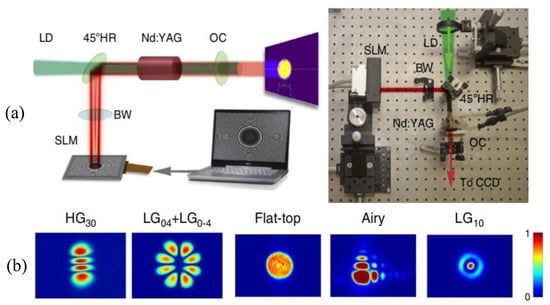
Figure 2.
(a) Experimental configuration of the proposed laser and (b) generated various laser modes by amplitude and phase modulation. (Adapted from an open-access source Ref. [63]).
Chen et al. proposed a dual-cavity digital laser in 2018 [64]. As shown in Figure 3a, the main body was an Nd:YAG laser. A twisted nematic SLM was used as an output coupler in the cavity. Two cavities of the laser share a common Nd:YAG rod and an output coupler. After passing through the intra-cavity polarizing beam displacer, the laser beam inside the cavity would be divided into two polarized light beams in the right and left directions. These two beams illuminated the right and left areas of the twisted nematic SLM loaded different holograms, respectively. The beams in the right and left directions were modulated, respectively. Structured beams could be produced by the superposition of two beams. The produced on-demand spatial modes are shown in Figure 3b. Rapid switching between laser modes was achieved. Additionally, the process of generating a vector beam by coherent superposition of two orthometric polarized HG beams was also demonstrated.
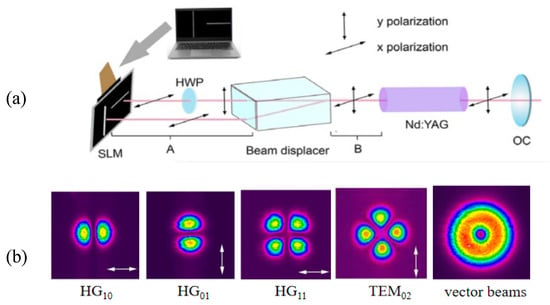
Figure 3.
(a) Schematic of the dual-cavity digital resonator and (b) different laser modes (Adapted from an open-access source Ref. [64]).
Compared to the linear cavity configuration, a folded cavity can decrease the peak power in the laser cavity and control the area of transverse mode easily [65,66]. In addition, the construction of solid-state laser with a folded structure was experimentally more convenient. A V-shaped laser was proposed to produce high-order HG mode directly from the resonator and further transform into the annular vortex light with a pair of cylindrical lenses [67]. The SLM was controlled by a computer and served as a mirror in the cavity. Two spherical mirrors were around the laser cavity. The mode order of the vortex beams was conveniently adjusted by holograms loaded on the SLM. The alignment was not necessary. Experimental configuration of the laser setup is displayed in Figure 4a. Some loaded holograms are shown in Figure 4b. Related output beam profiles are displayed in Figure 4c. The beam qualities of the HG modes directly output in the cavity were measured by CCD, and the OAM values of produced vortex beams were also measured with interferometry. The output power could be controlled with precision by changing the grayscale of holograms.
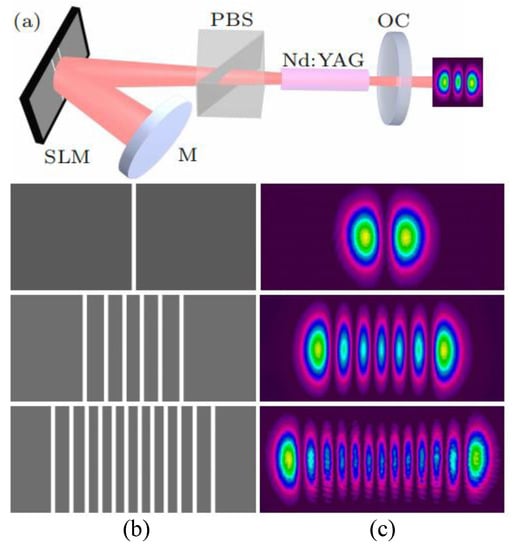
Figure 4.
(a) Experimental configuration of the digital V-shaped laser using a SLM; (b) Bar-grating-shaped holograms on the SLM and (c) the outputs of HG1,0, HG6,0, and HG12,0, respectively (Adapted from an open-access source Ref. [67]).
Huang et al. proposed a digital laser utilizing a SLM. It could generate structured light fields with controllable transverse intensity distributions by superimposing multi-point laser fields [68]. In this work, intensity profiles modulation was achieved using a phase-only SLM. By loading the controllable and required holograms on the SLM, the normal transmission of the required beam parts could be maintained while loss of other useless parts increased in the process of laser oscillation. Figure 5a displays the experimental setup of the digital resonator. An amplitude modulated mask was used on SLM in digital laser system. As shown in Figure 5b, experiments demonstrated discrete point, triangle, rectangle, and T-shaped intensity profiles generated by the digital laser. Obviously, the output had a lower brightness but more uniform field intensity distribution, which resulted from the diffraction effect of the SLM.
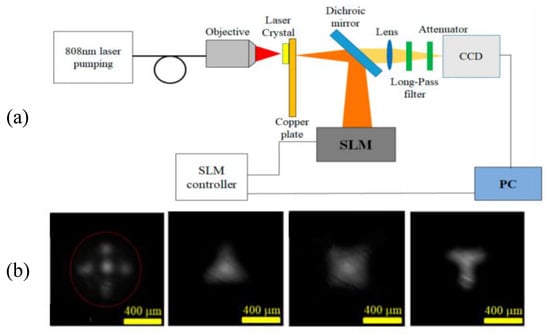
Figure 5.
(a) The laser that generates the laser beam of controllable intensity profiles and (b) the resulting field of discrete points, triangle, rectangular and ‘T’ shape field distributions (Adapted from an open-access source Ref. [68]).
In the previous works, the fast varied on-demand structured light fields could be produced by regulating pump beam profiles traditionally [69,70,71,72]. The utilization of the digital device (SLM, DMD) makes the quick adjusting of the pump intensity profiles possible. In 2019, Florian et al. presented an end-pumped Nd:YVO4 laser utilizing a controlled DMD. This laser generated structured beams had high-order HG modes [73]. The intensity profiles of pump beams were shaped with a DMD. The schematic of the DMD-controlled structured light laser is displayed in Figure 6a. The pump pattern was controlled by the DMD for the HG3,3 mode, and the relevant mode intensity profiles emitted from the resonator is displayed in Figure 6b. Besides, this laser enabled the controllable structured light beams output of about 1000 different higher order HGm,n modes.
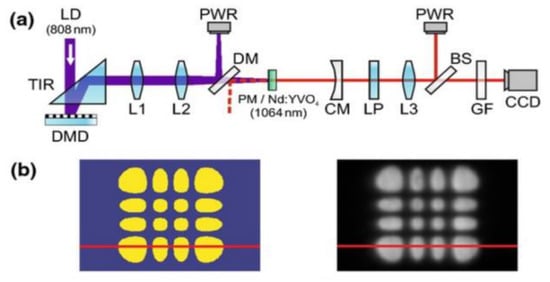
Figure 6.
(a) Schematic of the vector pump-shaping laser; (b) Pump patterns of the HG3,3 mode and corresponding CCD image (Adapted from an open-access source Ref. [73]).
HG modes and LG modes can be generated by shaping the pump patterns with the digital device. In 2021, Zhang et al. demonstrated a digital laser with controllable transverse modes. The gain of the laser medium was regulated through the switch of a DMD [74]. Pump beams reflected by the DMD focused on a 400 μm thick Nd:YAG through a short-focal lens. The desired images were plotted in a laptop and loaded onto the DMD. This laser system could easily and selectively generate the structural laser beams on demand, including HG modes, LG modes, and vortex array beams. Figure 7a displays the device diagram of the mode selection laser system, and Figure 7b shows mode patterns loaded on the DMD and the beam profiles of the pumped light and the output after regulating. Because of the grating effect formed by the diffraction of the micro-mirror array and the aberration of the intra-cavity lens, the pump light distribution in the gain medium was distorted to some extent. In 2022, Xiong G J et al. proposed an approach to produce the structured light fields with fractional/multifractional orders and superposition states utilising a DMD, and the OAM was less than five [75]. The dynamic regulation of the structured beams was also achieved.
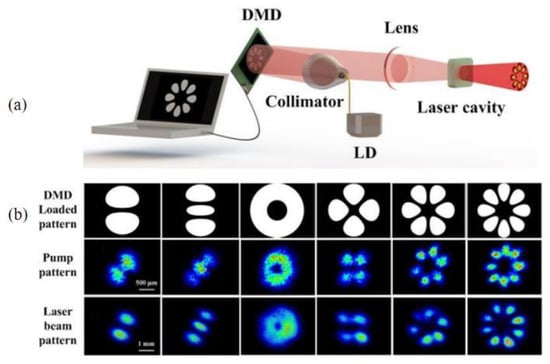
Figure 7.
(a) Schematic of the structured light laser using DMD; (b) The DMD loaded patterns, the corresponding pump beam profiles, and the output beam patterns in laser cavity (Adapted from an open-access source Ref. [75]).
More varied geometric structures with periodic distribution and higher spatial resolution can also be generated. In 2021, Chu et al. presented a digital laser by designing the phase boundary to generate structured light beams [76]. The resonator was mainly composed of a gain medium and a SLM. Structured light beams of specifying geometrical shape could be generated by utilizing the phase boundary matched with a target field of Gaussian-convoluted geometric structure field. The schematic of the proposed laser and structured light fields with geometric shapes is shown in Figure 8. Output with intensity distributions close to a quadrilateral pyramid, triangular pyramid, cone, and multi-ring have been obtained.
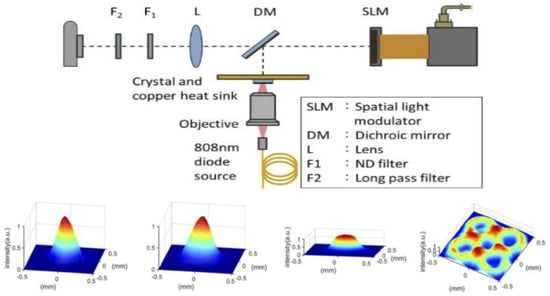
Figure 8.
Schematic of the structured light laser and the various light fields (Adapted from an open-access source Ref. [76]).
Quasi-Mathieu beams with non-diffracting characteristics have rich geometric structures, and they are generally used in soliton lattice manipulation [77] and material processing [78]. M.B.A. Elizondo et al. achieved the first generation of quasi-Mathieu beams with the intra-cavity method [79]. Mechanical adjusting was adopted in an axicon-based cavity to obtain the quasi-Mathieu beams with different orders. In order to improve the adjustment speed, Ly and Shu provided flexible approaches to selectivity produce various quasi-Mathieu beams in 2022. Figure 9a shows the L-shaped digital laser which can produce quasi-Mathieu beams. The selection of quasi-Mathieu beam could be regulated by the hologram on the SLM inside the laser cavity. The quasi-Mathieu beam with different rotation angles is shown in Figure 9b [80].
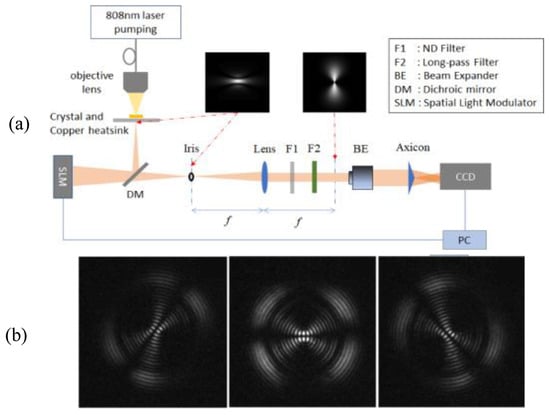
Figure 9.
(a) Schematic of the L-type digital lasers setup; (b) Quasi-Mathieu beams with different angles of 44°, 92°, and 136°, respectively (Adapted from an open-access source Ref. [80]).
The main challenges of the solid-state digital lasers are to find new approaches to optimize the laser systems and improve the arrangement of the components in the cavity. Further, the generated structured light on demand could be able to feature high output power, high mode purity.
From the viewpoint of geometry optics, a cavity can be regarded as a degenerate cavity when an arbitrary beam can realise self-reproduction to form a self-imaging system [81,82]. Since every different transverse mode in the degenerate cavity has nearly identical Q factors, or rather similar lasing thresholds, a degenerate cavity laser can emit many transverse modes with low coherence concurrently. In another word, degenerate cavity can be used to restrain photons at various states in a system [83]. The number and spatial coherence of modes in the degenerate cavity can be tuned easily with little loss of power. The degeneracy of various modes was routinely achieved by placing two lenses inside the laser cavity. Such a robust structure led to many potential applications.
The degenerate cavity can be combined with some optical modulator elements to form a system that converts the input Gaussian beams into the OAM structured beams. A completely degenerate ring cavity for Laguerre–Gaussian modes with 4 lenses and 4 mirrors were constructed by Cheng. A SLM was inserted into the cavity that transformed the signal beam into LG modes. A continuous ultranarrow bandwidth laser was split into two beams, which were considered as reference beam and signal beam, respectively. The signal beam emitted to a SLM and converted into the LG mode. This system supports more than 31 LG modes [84]. In 2019, a degenerate cavity with the same four ellipsoidal mirrors was also constructed by the group above. Two lasers with different wavelengths of 880 nm and 671 nm were emitted to a SLM, and the Gaussian beam mode was transformed into LG modes. Overall, 21 LG modes were supported at the same time [85]. In 2022, Yang et al. experimentally investigated the characteristics of a spin-orbital coupling topological system. There were two lenses in the degenerate cavity. High-order modes could be produced through passing a q-plate and a wave plate repeatedly with the input laser beams [86]. Qualified degenerate cavities are required to be high for the fabrication of optical components and the intra-cavity alignment. Imperfect intra-cavity components and arrangements will further lead to a deviation of LG modes with different topological charges [87]. The direct generation of structured light beams using intra-cavity optical elements is less affected by external factors and requires less alignment [88].
In 2018, Ronen et al. demonstrated a new method to efficiently and rapidly generate structured beams that allowed transmitting a constant shape using an improved degenerate cavity laser (MDCL) [89]. MDCL had extremely high degrees of freedom for coupling and control and supports a number of transverse modes. When a ring aperture was inserted into the Fourier plane inside the resonator, the output Bessel beam was similar to the desired transverse intensity profiles. Figure 10a shows the experimental setting and Figure 10b shows the simulation results of the beam diffraction varying with the transmission distance when the circular and ring aperture were inserted into the MDCL cavity, respectively.
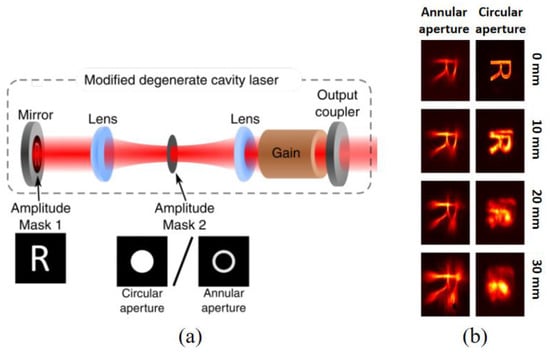
Figure 10.
(a) Schematic of the degenerate laser with an aperture of different shapes; (b) The measured intensity profiles after different propagation distances (Adapted from an open-access source Ref. [89]).
During the process of propagation, the conversion of the structured laser beam profiles can be achieved by dissipative coupling between the different modes. Chene et al. proposed a digital degenerate cavity laser (Figure 11) in 2021 which contained a SLM and two lens [90]. An “apple” pattern was loaded on a SLM at the near-field (z = 0 mm), and a “star” aperture was applied at the midfield, which was 100, 200, and 300 mm away from the SLM. The shape of the laser beam transformed into “star” pattern at midfield from “apple” pattern at near-field gradually. Figure 11 shows the intensity distribution under four different propagation distance. It was proved that a laser beam could be effectively regulated into entirely another pattern after propagating in free space by adjusting both the intensity, phase, and coherence distribution.
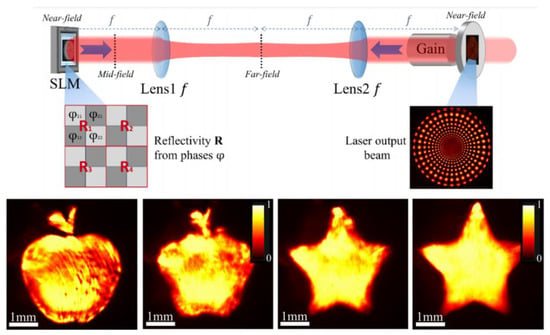
Figure 11.
Schematic of the digital linear laser, apple patterns at z = 0 mm, 100 mm, 200 mm, and star patterns at z = 300 mm (Adapted from an open-access source Ref. [90]).
Furthermore, high resolution output beams with many independent degrees of freedom were also obtained, which were even better than that of the traditional laser cavity. That includes the case of Newton’s mode and Einstein’s mode displayed in Figure 12. Power changes of Newton and Einstein modes during laser propagation were studied. The laser efficiencies of these two modes were about 50% and 40%, respectively, which were approximately equal to the average reflectivity of the SLMs in the cavity. Experiments have proved that, by modulating the phase or amplitude distribution of the digital degeneracy resonator, this laser could generate many unique, complex, high resolution laser beams with little variation of laser output power.
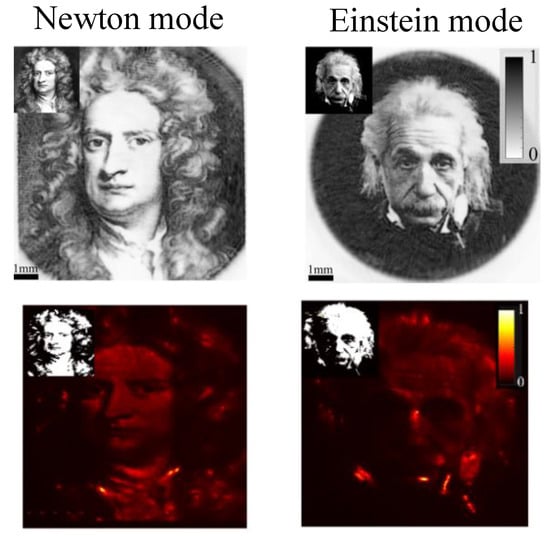
Figure 12.
Incoherent Newton shaped beam and Einstein shaped beam; “Newton mode” and ”Einstein mode” intensity distributions (Adapted from an open-access source Ref. [90]).
3.2. Fibre Digital Laser with SLMs
The generation of structured light fields in fibres is principally derived from the excitation and extraction of eigenmodes in dual-mode, four-mode, and other few-mode fibres (FMF). Generally, structured light fields can be generated by mode selection coupling [91], Bragg gratings [92], long-period fibre gratings (LPFG) [93,94], and so on. However, the aforementioned fibre devices always operate in a narrow band and have a high loss in the generation. Therefore, the wavelength tunability and the laser efficiency would be limited. The use of SLM can result in more convenient mode control and possibly higher output mode. The requirements for fibre fabrication and refractive index profile are not strict in a digital fibre laser. The propagation and amplification of the OAM beams in fibre digital lasers are more stable, and the mode coupling efficiency is higher. Moreover, the fibre digital lasers are robust and reproducible [95,96].
In 2017, Tian et al. proposed a fibre laser with a simple structure based on SLM and single-mode fibre shown in Figure 13a [97]. Pumped by a 980 nm single mode laser, the high order transverse mode laser at 1550 nm with high purity and quality was emitted according to the requirement. The purpose of SLM was to provide topological charges on demand. By setting the SLM, Gaussian modes could be transformed into the higher-order mode on demand, that could also be decomposed into the fundamental mode, presenting different diffraction angles. The required higher-order modes would emit, while the remaining fundamental modes were coupled to the fibre ring cavity again. The intensity distribution of LP01, LP11, LP21, and LP02 laser modes in FMF is also demonstrated in experiments, as shown in Figure 13b.
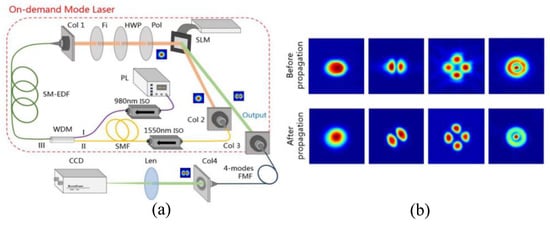
Figure 13.
(a) Schematic of structured light laser with switchable modes and (b) intensity profiles of the different modes in few-mode fibre (Adapted from an open-access source Ref. [97]).
While a beam with continuous wavelengths passing through a substance, some bands of the beam will be weakened. The composition of the substance can be determined by analysing the absorption spectrum. Therefore, spectroscopy is an important tool in the non-invasive detective work [98,99]. Thus, it is necessary to implement the adjustment of the laser wavelength and optimize the spectral profile. The tuneable wavelength and reconfigurable OAM can be realized at the same time by combining the free-space and fibre control. In 2018, Zhou et al. put forward a fibre laser which could produce vortex output carrying high OAM values [100]. As shown in Figure 14a, a Gaussian to OAM to Gaussian conversion module was used to support determined OAM reconfigurable operation. By properly adjusting the pattern on SLMs, tuneable wavelength and reconfigurable OAM were achieved. During the experiments, topological charges ranged from −10 to +10 when patterns on SLMs were different, and the wavelength could also be adjusted from 1530 to 1565 nm. Figure 14b,c show the intensity distributions and interferograms for different topological charges at 1550 nm.
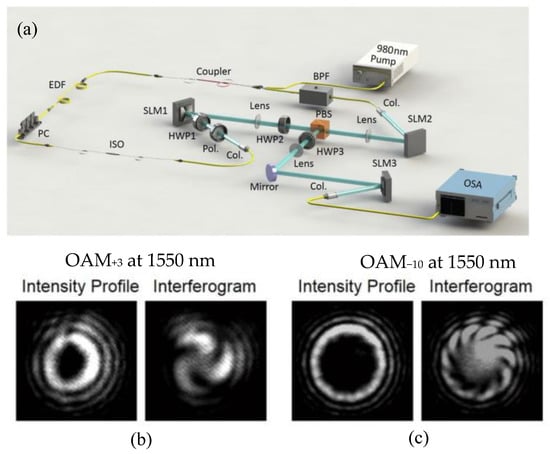
Figure 14.
(a) Experimental configuration of the twisted light laser. Experimental intensity distributions and interferograms of (b) OAM+3 and (c) OAM−10 at 1550 nm (Adapted from an open-access source Ref. [100]).
It is still a challenge to achieve structured light output with high power, high purity, and tuneable order in a compact laser system, while there is no damage to the intra-cavity optical devices such as SLMs [101]. In order to overcome this kind of limitation, Lin et al. demonstrated a digital fibre amplifier based upon adaptive shaping of the wavefront and polarization of the intra-cavity light field in 2021 [102]. A SLM was inserted in the front of a FMF laser amplifier. The system could generate various spatial modes under the control of an electrical signal, including traditional LP mode, OAM mode, and a column vector mode. Figure 15 shows the structure of the digital fibre laser amplifier and the intensity distribution of the output OAM light carrying various topological charges. Finally, the gain of the fibre laser reached 16 dB.
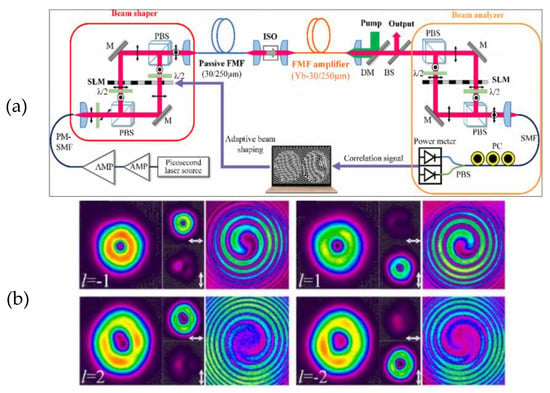
Figure 15.
(a) Schematic of the fibre laser. (b) Intensity distributions and corresponding phase patterns of vortex beams carrying different OAM values (Adapted from an open-access source Ref. [102]).
Only a few modes are supported in the FMF, therefore the SLM or DMD is seldom used in fibre lasers. It is expected that introducing the SLM/DMD into multi-mode fibre lasers to realize the output with controllable higher modes may become the future research direction.
4. Structured Light Laser Based on Metasurfaces
Metasurfaces are a kind of artificial composite, and the distinctive properties of the metasurfaces are derived from the elaborate structure configuration of the tiny constituents [103,104]. The capability of wavefront shaping is the most important characteristic of the metasurface [105]. By increasing the interaction between beams and object, full control of the optical wavefront by means of subwavelength structural unit can be realized. Moreover, the optical wavefront can be manipulated, then the propagation and divergence of the beams can also be controlled by changing the metasurfaces’ spatial arrangement. The ability of metasurfaces to regulate polarization is based on optical wavefront modulation. The incident light will split into two orthogonal components, and the required phase delay can be established. Intra-cavity metasurfaces are ideal materials for generating laser beams with different topological charges. Metasurfaces are beneficial for simplifying the structure of the laser system and reducing the error of manual modulation [106].
4.1. Solid-State Laser with Metasurfaces
When the metasurfaces are used in solid-state lasers to generate structured beams, there are generally two cases: (1) Inserting a metasurface into the cavity, the metasurface will interact with the laser resonator. Since the mode area of the laser gain inside the resonator increases, the laser output power is also improved. (2) Employing metasurfaces to take the place of output couplers in the resonator. Only the output part of the beams interacts with the metasurface to produce the structured beams, meanwhile other parts of the beams still reflect back to the resonator and continue to oscillate. As an output coupler, the metasurface does not interact with the resonator so it will not impact the laser mode. Pancharatnam–Berry phase optical elements (PBOEs) could be regarded as a metasurface containing spin-orbit interaction, which was employed by Elhanan et al. in 2018. It was the first time to control the laser cavity mode by using a dielectric metasurface [107]. Since the PBOE inside the cavity interacted with the resonator, the efficiency of the PBOE could be improved as the increasing of the mode area. Figure 16a displays the experimental setup of the laser, and the laser system produced a Gaussian beam at one end and an annular vortex beam at the other end. Figure 16b,c display the intensity distributions of OAM with l = ±1. Time-domain finite-difference was used to predict a metasurface efficiency of 82% at 1.064 μm wavelengths, and the efficiency in the experiment was 73%. Mode purity reached 95.7%, and polarization purity reached 94% by measuring the polarization state and the Stokes polarization parameters. The intra-cavity reflective PBOE utilized in this work can also be applied in ultrafast lasers [108] for its wavelength-independent characteristic. In addition, thanks to the compact structure, it can also be integrated into the micro-lasers.
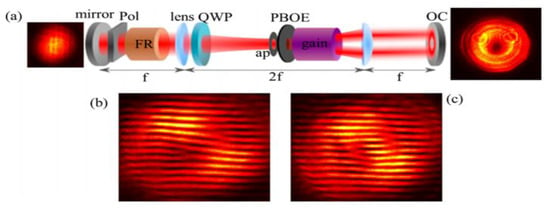
Figure 16.
(a) Diagrammatic experimental setup of the modified degenerate laser. Self-interference patterns of vortex beam modes, including (b,c) the topological charges l = ±1, respectively (Adapted from an open-access source Ref. [108]).
In the same year, by using the interleaved metasurfaces, Ronen et al. generated vector vortex beams though coherent superposition of scalar vortex beams with inverse OAM values and spin states [109]. Figure 17 shows the structure of the twisted improved degenerate laser and the intensity profiles of OAM beams. Laser output coupler was replaced with a designed shared-aperture multi-tasking metasurface, which allowed us to produce some desired structured light fields independently at the same time. By matching the conversion efficiency of the geometric phase metasurface (GPM) with the optimal reflectivity of the rear mirror, the efficiency of the element has been increased. Generated OAM beams had controllable spatial coherence and high flexibility. An aperture was applied at the middle far fields in the resonator to make a selection of laser modes. Additionally, the overall output power of the system would almost not be affected, as the filter effect operated on the far fields and only had an effect on the frequency.

Figure 17.
(a) Experimental setup of the degenerate laser using (b) a metasurface. (c), (d) Measured OAM output and self interference pattern at different channels. (Adapted from an open-access source Ref. [109]).
Owing to the distinct properties of non-diffracting propagation and self-reconstruction, Bessel beams have aroused wide attention. Nevertheless, Bessel beam is an approximate solution of finite domain diffraction integral equation and a particular solution of wave equation in unbounded space. It is basically impossible to obtain for its infinite transverse intensity profile [110,111]. Thus, Bessel-Gaussian (BG) beams can be approximated as perfect. Furthermore, lens could be considered to convert the BG beams to perfect vortex beams. Various efficient generation methods of BG beams have been proposed [112,113]. In general, SLMs can be utilized to modulate the wavefront phase of an incident beam, then stable Bessel beams will be produced by passing the modulated beams through an axicon. However, a metasurface can realize the combination function uniformly of the SLM and axicon. Zhou et al. designed a BG laser, and its resonator was a Fabry–Perot cavity [114]. One of the mirrors was a partially reflected output coupler, and a reflective metasurface was substituted for the other mirror. A mode selective element (MSE) was also placed in the resonator to directly generate BG laser modes of 0–3 ℏ with controllable helical phase by adjusting the output coupler radius and MSE (Figure 18).

Figure 18.
Experimental setup of the structured light laser. Simulated multi-ring intensity distribution of OAM-carrying Bessel beams with different modes (Adapted from an open-access source Ref. [114]).
High-order super-chiral structured light beams are widely used in many fields [115,116]. The requirement for the purity of the structured light is higher and higher to meet the tremendous development of the basic and applied research. In 2020, Sroor et al. designed and fabricated metasurfaces to form a structured light laser to achieved super-chiral beams [117]. A J-plate and an intra-cavity non-linear crystal (KTP) were inserted inside the resonator, and the infrared beams of 1064 nm realized the frequency doubling, as shown in Figure 19a. OAM beams from the laser with a difference in helicity of up to 90 were obtained. Figure 19b displayed intensity distributions of OAM beams with the OAM l = 10 using intra-cavity methods and extra-cavity methods, respectively. It is clear that the intensity distribution produced with the intra-cavity method has a clearer ring structure, and the purity of the intensity distribution arrives at 92%. The mode purity of vortex beams is much better with the intra-cavity method than that with the extra-cavity method. Moreover, when the topological charge was higher, like l = 100 as shown in Figure 19c, the difference in purity became more obvious.

Figure 19.
(a) Schematic of the resonator using a metasurface (J-plate); (b,c) represent the output laser modes modulated with intra-cavity and external cavity approaches when the topological charge l = 10, 100, respectively (Adapted from an open-access source Ref. [117]).
Vortex laser arrays are a type of promising structured light fields that have large application potential in atom guiding and other fields [118,119,120]. Well-designed optical vortices crystals [121] and 2-dimensional phase plates [122] can all be used to modulate the OAM laser array. In order to obtain the structured light beam array with controllable OAM and high purity, in 2022, Marco et al. presented a degenerate laser that could produce vortex laser arrays based on metasurfaces [123]. The diagrammatic experimental setup of the degenerate structured light resonator is shown in Figure 20a. The transverse cross-section of the gain medium was large enough to support a number of modes. The output coupler was displaced by a metasurface. According to the Talbot effect, the output beams propagating through the metapurface in the right direction will self-image after the appropriate distance. The metasurface consisted of 10 × 10 metasurfaces, which can realize the conversion of the Gaussian beams array to the vortex beams array. A metallic mask with the pinhole array was filled in the interstices between the metasurface which could spatially filter the transmission of the beams. Due to the joint action of the polarization device inside the cavity and the metasurface, the superposition and reduction of vortex terms were realized by passing the metasurface in different directions. In the different ends of the resonator, different intensity profiles (Gaussian beam array shown in Figure 20b and annular-shaped beam array shown in Figure 20c) were also realized simultaneously. Conversion of the topological charge occurred inside the cavity. Next, a SLM was used for the modal decomposition of all vortices over the array at once, and the measured charge purity was close to 100%.
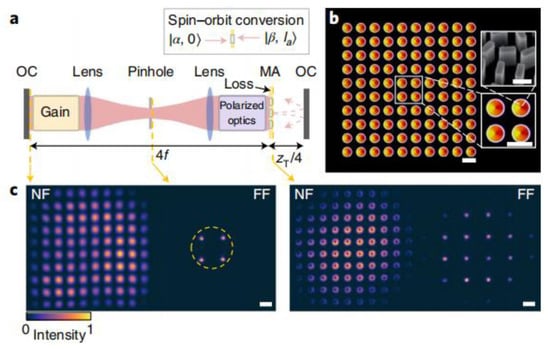
Figure 20.
(a) Diagrammatic experimental setup of the laser degenerate resonator using a metasurface array; (b) Optical image of the metasurface array; (c) Experimental intensity profiles of the arrays at near field and far field in the front and rear end of the resonator, respectively (Adapted from an open-access source Ref. [123]).
4.2. Fibre Laser with Metasurfaces
By coupling the metasurface on the end face of a fibre or integrating a metasurface into the fibre laser, the output beam in the free space can be controlled. Some relevant purposes can be achieved using metasurfaces regulating the light fields inside the fibre laser, such as mode conversion and polarization conversion. Wang et al. demonstrated a fibre laser using metasurface in 2020 [124]. OAM beams with l = 1 was generated directly. The fibre core is mainly doped with Yb ions. The metasurface was formed from a number of gold nano-antenna. When the horizontally polarized incident light illuminated on the metasurface, it could be transformed into the vertically polarized vortex light and horizontally polarized light. The vortex light at vertically linearly polarized state would output to the CCD and the vortex light at horizontally linearly polarized state would continue to transmit in the fibre resonator. The whole resonator structure is shown in Figure 21, and this system made the initial light beam amplified enough in the transmission process before the metasurface. The intra-cavity metasurface was able to transform the Gaussian beam to an OAM beam. It has the potential to generate structured light fields with high power and great purity.
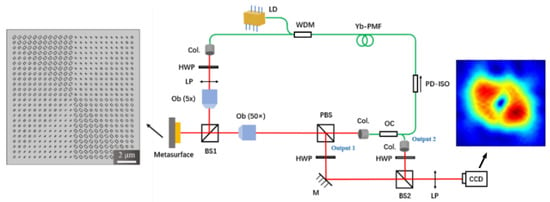
Figure 21.
Schematic of the metasurface-assisted structured light fibre laser (Adapted from an open-access source Ref. [124]).
Wavelength tunability is one of the most important capabilities of structured light lasers, particularly in the applications of optical communications [125,126]. In 2021, the first generation of LG01 mode at 670.4 nm was reported with off-axis pumping by Lin X J [127]. The proposed Pr3+:YLF laser had the tuneable characteristic around the visible output wavelength. The output power and slope efficiency were also remarkable. Structured light lasers with tuneable wavelengths and OAM modes were greatly desired. In 2022, Gui et al. presented a structured light fibre laser with an extreme-wide wavelength tuning range utilizing a metasurface [128]. The gap-surface plasmon (GSP) metasurface had different polarization conversion efficiencies. Structured light fields with topological charges l = ±1 were generated directly. Combined with the tuneable filter inserted inside the fibre cavity, centre wavelengths of the structured light output allowed to be adjusted between 1015 nm and 1075 nm conveniently and efficiently. Figure 22 shows the diagram of the tuneable laser and intensity profiles of vortex light beams at different wavelengths. All formed beams within a wavelength span of 60 nm had great OAM mode purity (maintained at about 90%). This laser exhibited several fascinating advantages, like compact structure, convenient to operate, and the stability control of centre wavelengths.
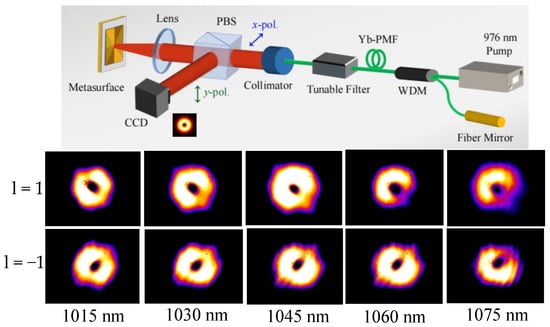
Figure 22.
Schematic of the structured light fibre laser and intensity profiles of structured light beams with l = ±1, the wavelength could vary between 1015 nm and 1075 nm (Adapted from an open-access source Ref. [128]).
5. Integrated Micro-Lasers
With the development of micromachining technology and further research on integrated photonics devices, miniaturized and integrated emitters of structured light fields lead to added potential benefits. Spiral phase plates of micron or submicron size can be integrated into microring laser devices to produce structured light. Li et al. made a miniature spiral phase plate on a low-cost semiconductor laser, and the desired structured light fields could be generated from the original Gaussian beams [129]. Rodrigues et al. used the focused ion beam to process a micro-scale spiral phase plate to the end of a fibre. A LG mode was obtained from the guided mode of the fibre [130].
Dynamically alterable structured light fields have become the necessary conditions for the realization of the emerging photonic technologies. There is also an approach to generate structured light fields directly at the micro-scale. Cai et al. generated flexible and reconfigurable vector optical vortices from notched microring resonators [131]. Angular gratings were used to extract the light limited to the whispering gallery into the free space vertically. The schematic diagram is shown in Figure 23a. Furthermore, multiple optical vortices from integrated emitter arrays were also implemented. The topological charges depended on the order of whispering gallery modes and the number of grating elements on the ring. The centrosymmetric structure of the whispering gallery determined the polarization characteristics of the generated vortex beam. Figure 23b–d show the microscopic image of the microring resonators, the corresponding light field patterns, and interference patterns, respectively. This work provided a more compact solution to produce structured light beams with high purity. In 2016, Miao et al. has realized a real micro-vortex beam laser [132]. They achieved unidirectional power oscillation and made a micro-resonant cavity with gain by using InGaAsP/InP semiconductor material. The regions of gains and losses with appropriate spacing have been introduced into the microring resonator. The exceptional point was formed to break the symmetry. Under the corporate action of angular gratings and the pump, vortex beams with alterable OAM values and vector polarization states could be directly generated. Then, a new kind of integrated micro-laser based on the time-reversal symmetry was proposed, which could be extended to different structures. In 2020, Zhang et al. implemented the precisely manipulation of chiral optical states in microring lasers [133]. The micro-laser was composed of a microring resonator and an external feedback loop. The breaking of non-Hermitian symmetry boosted the promotion of the degeneracy between two spin-orbit coupled states and achieved the emission of the vortex laser with tuneable OAM values.
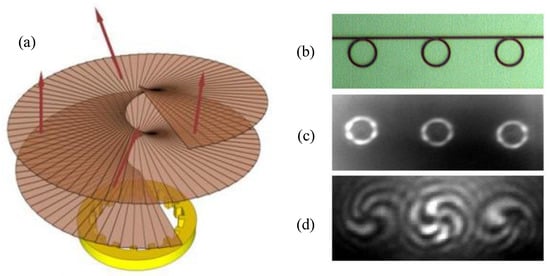
Figure 23.
(a) Schematic diagram of the angular grating and the helical wave-front of the radiated beam. (b) The microscopic diagram of the integrated device. (c) The intensity distributions of the vortex beams (l = −3) generated by the integrated device. (d) The corresponding interference patterns between the vortex beam and the right-hand circularly polarized Gaussian beam (Adapted from an open-access source Ref. [131]).
At present, researchers have developed a variety of new integrated optoelectronic devices, utilizing the advantages of compact structure and high-quality factor of the optical microcavity [134,135,136,137]. Compared with the structured light fields generated by the discrete devices such as spiral phase plates or SLMs, the former has solved the problems of cost, volume, and stability to some extent.
6. Conclusions and Perspectives
Structured light beams carrying OAM have the unique intensity, phase, and polarization distributions, and can be artificially tailored according to the demand. The emergence of the structured light beams leads to a number of significant applications. With the development of many fields in the future such as biomedicine and materials processing, perhaps scholars in these fields do not have the expertise in structured light, as the devices that generate the structured beams directly would be the best choice. Thus, the exploration of the intra-cavity generation of the structured beams with higher purity, order, and efficiency has become an inevitable trend.
In this review, the methods about how to generate the structured light fields inside the laser cavity are reviewed. Although the real-time formation of the laser with different modes on demand is implemented conveniently and rapidly by loading different patterns on an intra-cavity SLM, the refresh rates and resolution of the digital laser need to be raised. Otherwise, the damage threshold of SLMs will restrict the maximum output of digital lasers. Scaling the mode size on the SLM is available for obtaining a high power or pulse output and avoiding the damage. In contrast, metasurface approaches have a high resolution at the nanometre scale and a high damage threshold. However, the efficiency will be affected by the manufacturing tolerance of the metasurface. With the rapid development of new materials and the advantages in cost, miniaturization, and stability, microlasers that can generate arbitrary structured light fields have very considerable prospects.
In the future, the problem of generating more effective and robust structure beams with high power, high purity, and tailorable spatial intensity distribution still need to explore. Considering the low efficiency, short service life, and high cost of optical devices in structured light lasers, a structured light amplifier may be a promising prospect. In this way, requirements of high power and high purity can be handled separately. Thanks to the flexibility of digital lasers, a large number of controllable output light fields can be combined with deep learning, and the spatial light modulator inside the laser cavity can be controlled intelligently according to the feedback of output characteristics.
Author Contributions
Conceptualization, S.W.; validation, S.W.; investigation, S.W. and P.G.; resources, S.W.; writing—original draft preparation, P.G.; writing—review and editing, S.W. and P.G. All authors have read and agreed to the published version of the manuscript.
Funding
This research was funded by The National Natural Science Foundation of China, grant number 61975137.
Institutional Review Board Statement
Not applicable.
Informed Consent Statement
Not applicable.
Conflicts of Interest
The authors declare no conflict of interest.
References
- Rubinsztein-Dunlop, H.; Forbes, A.; Berry, M.V.; Dennis, M.R.; Andrews, D.L.; Mansuripur, M.; Denz, C.; Alpmann, C.; Banzer, P.; Bauer, T.; et al. Roadmap on structured light. J. Opt. 2016, 19, 13001. [Google Scholar] [CrossRef]
- Rozas, D.; Law, C.T.; Swartzlander, G.A. Propagation dynamics of optical vortices. J. Opt. Soc. Am. B 1997, 14, 3054–3065. [Google Scholar] [CrossRef]
- Forbes, A. Structured light from lasers. Laser Photonics Rev. 2019, 13, 1900140. [Google Scholar] [CrossRef]
- Shujun, Z.; Xiao, L.; Zhiyun, H.; Lu, H.; Yuanying, Z.; Yi, Y.; Xiaodi, T. Light field regulation based on polarization holography. Opto-Electron. Eng. 2022, 49, 220114. [Google Scholar]
- Grier D, G. A revolution in optical manipulation. Nature 2003, 424, 810–816. [Google Scholar] [CrossRef] [PubMed]
- Pettit, R.M.; Ge, W.; Kumar, P.; Luntz-Martin, D.R.; Schultz, J.T.; Neukirch, L.P.; Bhattacharya, M.; Vamivakas, A.N. An optical tweezer phonon laser. Nat. Photonics 2019, 13, 402–405. [Google Scholar] [CrossRef]
- Shen, Z.; Xiang, Z.; Wang, Z.; Shen, Y.; Zhang, B. Optical spanner for nanoparticle rotation with focused optical vortex generated through a Pancharatnam–Berry phase metalens. Appl. Opt. 2021, 60, 4820–4826. [Google Scholar] [CrossRef]
- Bustamante, C.J.; Chemla, Y.R.; Liu, S.; Wang, M.D. Optical tweezers in single-molecule biophysics. Nat. Rev. Methods Prim. 2021, 1, 25. [Google Scholar] [CrossRef]
- Guo, Z.Y.; Gong, C.F.; Liu, H.J.; Li, J.J.; Wang, Z.K. Research advances of orbital angular momentum based optical communication technology. Opto-Electron. Eng. 2020, 47, 190593. [Google Scholar]
- Neary, P.L.; Watnik, A.T.; Judd, K.P.; Lindle, J.R.; Flann, N.S. Machine learning-based signal degradation models for attenuated underwater optical communication OAM beams. Opt. Commun. 2020, 474, 126058. [Google Scholar] [CrossRef]
- Hemani, K.; Georges, K. Optical communication in space: Challenges and mitigation techniques. IEEE Commun. Surv. Tutor. 2017, 19, 57–96. [Google Scholar]
- Willner, A.E. OAM light for communications. Opt. Photonics News 2021, 32, 34–41. [Google Scholar] [CrossRef]
- Liu, J.; Hua, Z.; Liu, C. Compact dark-field confocal microscopy based on an annular beam with orbital angular momentum. Opt. Lett. 2021, 46, 5591–5594. [Google Scholar] [CrossRef]
- He, H.; Kong, C.; Chan, K.Y.; So, W.L.; Wong, K.Y. Resolution enhancement in an extended depth of field for volumetric two-photon microscopy. Opt. Lett. 2020, 45, 3054–3057. [Google Scholar] [CrossRef] [PubMed]
- Liu, Y.; Chen, W.; Tang, J.; Xu, X.; Chen, P.; Ma, C.; Zhang, W.; Wei, B.; Ming, Y.; Cui, G.; et al. Switchable Second-Harmonic Generation of Airy Beam and Airy Vortex Beam. Adv. Opt. Mater. 2020, 9, 2001776. [Google Scholar] [CrossRef]
- Xu, Z.; Lin, Z.; Ye, Z.; Chen, Y.; Hu, X.; Wu, Y.; Zhang, Y.; Chen, P.; Hu, W.; Lu, Y.; et al. Control the orbital angular momentum in third-harmonic generation using quasi-phase-matching. Opt. Express 2018, 26, 17563–17570. [Google Scholar] [CrossRef]
- Wang, Y.; Yong, K.; Tang, S.; Zhang, R. Illumination characteristics of vortex beams in dark-field microscopic systems. Appl. Opt. 2021, 60, 2269–2274. [Google Scholar] [CrossRef]
- Guo, C.-S.; Xue, D.-M.; Han, Y.-J.; Ding, J. Optimal phase steps of multi-level spiral phase plates. Opt. Commun. 2006, 268, 235–239. [Google Scholar] [CrossRef]
- Zhan, Q. Cylindrical vector beams: From mathematical concepts to applications. Adv. Opt. Photonics 2009, 1, 1–57. [Google Scholar] [CrossRef]
- Piccardo, M.; Ginis, V.; Forbes, A.; Mahler, S.; Friesem, A.A.; Davidson, N.; Ren, H.; Dorrah, A.H.; Capasso, F.; Dullo, F.T.; et al. Roadmap on multimode light shaping. J. Opt. 2021, 24, 13001. [Google Scholar] [CrossRef]
- Ren, Y.; Qiu, S.; Liu, T.; Liu, Z. Compound motion detection based on OAM interferometry. Nanophotonics 2022, 11, 1127–1135. [Google Scholar] [CrossRef]
- Ryabtsev, A.; Pouya, S.; Safaripour, A.; Koochesfahani, M.; Dantus, M. Fluid flow vorticity measurement using laser beams with orbital angular momentum. Opt. Express 2016, 24, 11762–11767. [Google Scholar] [CrossRef] [PubMed]
- Deng, D.; Zhao, H.; Ni, J.; Li, Y.; Qiu, C.-W. A phase-to-intensity strategy of angular velocity measurement based on photonic orbital angular momentum. Nanophotonics 2021, 11, 865–872. [Google Scholar] [CrossRef]
- Wang, J.; Liang, Y. Generation and detection of structured light: A review. Front. Phys. 2021, 9, 688284. [Google Scholar] [CrossRef]
- Angelsky, O.V.; Bekshaev, A.Y.; Hanson, S.G.; Zenkova, C.Y.; Zheng, J. Structured light: Ideas and concepts. Front. Phys. 2020, 8, 144. [Google Scholar] [CrossRef]
- Forbes, A. Controlling light’s helicity at the source: Orbital angular momentum states from lasers. Philos. Trans. R. Soc. A Math. Phys. Eng. Sci. 2017, 375, 20150436. [Google Scholar] [CrossRef]
- Chen, J.; Wan, C.; Zhan, Q. Engineering photonic angular momentum with structured light: A review. Adv. Photonics 2021, 3, 064001. [Google Scholar] [CrossRef]
- Cao, H.; Chriki, R.; Bittner, S.; Friesem, A.A.; Davidson, N. Complex lasers with controllable coherence. Nat. Rev. Phys. 2019, 1, 156–168. [Google Scholar] [CrossRef]
- Shen, Y.; Wang, X.; Xie, Z.; Min, C.; Fu, X.; Liu, Q.; Gong, M.; Yuan, X. Optical vortices 30 years on: OAM manipulation from topological charge to multiple singularities. Light. Sci. Appl. 2019, 8, 90. [Google Scholar] [CrossRef]
- Carrion-Higueras, L.; Alcusa-Saez, E.P.; Diez, A.; Andres, M.V. All-fiber laser with intracavity acousto-optic dynamic mode converter for efficient generation of radially polarized cylindrical vector beams. IEEE Photonics J. 2016, 9, 1–7. [Google Scholar] [CrossRef]
- Wei, D.; Cheng, Y.; Ni, R.; Zhang, Y.; Hu, X.; Zhu, S.; Xiao, M. Generating controllable Laguerre-Gaussian laser modes through intracavity spin-orbital angular momentum conversion of light. Phys. Rev. Appl. 2019, 11, 014038. [Google Scholar] [CrossRef]
- Chen, D.; Miao, Y.; Fu, H.; He, H.; Tong, J.; Dong, J. High-order cylindrical vector beams with tunable topological charge up to 14 directly generated from a microchip laser with high beam quality and high efficiency. APL Photonics 2019, 4, 106106. [Google Scholar] [CrossRef]
- Ma, Y.; Lee, A.J.; Pask, H.M.; Miyamoto, K.; Omatsu, T. Geometrical Laguerre-Gaussian mode generation from an off-axis pumped Nd:GdVO4 degenerate laser. In Proceedings of the 2021 Conference on Lasers and Electro-Optics Europe and European Quantum Electronics Conference, Munich, Germany, 21–25 June 2021. [Google Scholar]
- Li, X.; Chu, J.; Smithwick, Q.; Chu, D. Automultiscopic displays based on orbital angular momentum of light. J. Opt. 2016, 18, 85608. [Google Scholar] [CrossRef]
- Wang, M.; Ma, Y.; Sheng, Q.; He, X.; Liu, J.; Shi, W.; Yao, J.; Omatsu, T. Laguerre-Gaussian beam generation via enhanced intracavity spherical aberration. Opt. Express 2021, 29, 27783. [Google Scholar] [CrossRef] [PubMed]
- Zhang, S.; Li, P.; Wang, S.; Feng, G.; Zhou, S. Direct excitation of chirality controllable LG01 vortex beam in solid-state lasers by intracavity astigmatism manipulation. Laser Phys. Lett. 2019, 16, 035002. [Google Scholar] [CrossRef]
- Shen, Y.; Meng, Y.; Fu, X.; Gong, M. Wavelength-tunable Hermite–Gaussian modes and an orbital-angular-momentum-tunable vortex beam in a dual-off-axis pumped Yb:CALGO laser. Opt. Lett. 2018, 43, 291–294. [Google Scholar] [CrossRef]
- Shen, Y.; Meng, Y.; Fu, X.; Gong, M. Dual-wavelength vortex beam with high stability in a diode-pumped Yb: CaGdAlO4 laser. Laser Phys. Lett. 2018, 15, 55803. [Google Scholar] [CrossRef]
- Jack, B.; Yao, A.M.; Leach, J.; Romero, J.; Franke-Arnold, S.; Ireland, D.G.; Barnett, S.; Padgett, M. Entanglement of arbitrary superpositions of modes within two-dimensional orbital angular momentum state spaces. Phys. Rev. A 2010, 81, 043844. [Google Scholar] [CrossRef]
- Yue, Z.; Li, J.; Li, J.; Zheng, C.; Liu, J.; Wang, G.; Xu, H.; Chen, M.; Zhang, Y.; Zhang, Y.; et al. Terahertz metasurface zone plates with arbitrary polarizations to a fixed polarization conversion. Opto-Electron. Sci. 2022, 1, 210014. [Google Scholar] [CrossRef]
- Lin, D.; Carpenter, J.; Feng, Y.; Jain, S.; Jung, Y.; Feng, Y.; Zervas, M.N.; Richardson, D.J. Reconfigurable structured light generation in a multicore fibre amplifier. Nat. Commun. 2020, 11, 3986. [Google Scholar] [CrossRef]
- Veinhard, M.; Bellanger, S.; Daniault, L.; Fsaifes, I.; Bourderionnet, J.; Larat, C.; Lallier, E.; Brignon, A.; Chanteloup, J.-C. Orbital angular momentum beams generation from 61 channels coherent beam combining femtosecond digital laser. Opt. Lett. 2020, 46, 25–28. [Google Scholar] [CrossRef]
- Bell, T.; Ngcobo, S. Extra-cavity amplification of the digital laser modes using nd: Yag amplifier. In Applications and Technology; Optica Publishing Group: Washington, DC, USA, 2018. [Google Scholar]
- Maurer, C.; Jesacher, A.; Bernet, S.; Ritsch-Marte, M. What spatial light modulators can do for optical microscopy. Laser Photonics Rev. 2010, 5, 81–101. [Google Scholar] [CrossRef]
- Forbes, A. Laser Beam Propagation: Generation and Propagation of Customized Light; CRC Press: Boca Raton, FL, USA, 2014. [Google Scholar]
- Huignard, J.P. Spatial light modulators and their applications. J Optics 1987, 18, 181. [Google Scholar] [CrossRef]
- Neff, J.A.; Athale, R.A.; Lee, S.H. Two-dimensional spatial light modulators: A tutorial. Proc. IEEE 1990, 78, 826–855. [Google Scholar] [CrossRef]
- Savage, N. Digital spatial light modulators. Nat. Photonics 2009, 3, 170–172. [Google Scholar] [CrossRef]
- Li, R.; Ren, Y.; Liu, T.; Wang, C.; Liu, Z.; Zhao, J.; Sun, R.; Wang, Z. Generating large topological charge Laguerre–Gaussian beam based on 4K phase-only spatial light modulator. Chin. Opt. Lett. 2022, 20, 120501. [Google Scholar] [CrossRef]
- Kotlyar, V.V.; Kovalev, A.A.; Kozlova, E.S.; Savelyeva, A.A.; Stafeev, S.S. New type of vortex laser beams: Squared Laguerre-Gaussian beam. Optik 2022, 270, 169916. [Google Scholar] [CrossRef]
- Ohtake, Y.; Ando, T.; Fukuchi, N.; Matsumoto, N.; Ito, H.; Hara, T. Universal generation of higher-order multiringed Laguerre-Gaussian beams by using a spatial light modulator. Opt. Lett. 2007, 32, 1411–1413. [Google Scholar] [CrossRef]
- Carvajal, N.A.; Acevedo, C.H.; Moreno, Y.T. Generation of perfect optical vortices by using a transmission liquid crystal spatial light modulator. Int. J. Opt. 2017, 2017, 6852019. [Google Scholar] [CrossRef]
- Huang, X.; Chang, Z.; Zhao, Y.; Wang, Y.; Zhu, X.; Zhang, P. Generation of the anomalous vortex beam by spiral axicon implemented on spatial light modulator. Front. Phys. 2022, 10, 951516. [Google Scholar] [CrossRef]
- Dudley, A.; Vasilyeu, R.; Belyi, V.; Khilo, N.; Ropot, P.; Forbes, A. Controlling the evolution of nondiffracting speckle by complex amplitude modulation on a phase-only spatial light modulator. Opt. Commun. 2012, 285, 5–12. [Google Scholar] [CrossRef]
- Forbes, A.; Dudley, A.; McLaren, M. Creation and detection of optical modes with spatial light modulators. Adv. Opt. Photonics 2016, 8, 200–227. [Google Scholar] [CrossRef]
- Reichelt, S.; Häussler, R.; Fütterer, G.; Leister, N.; Kato, H.; Usukura, N.; Kanbayashi, Y. Full-range, complex spatial light modulator for real-time holography. Opt. Lett. 2012, 37, 1955–1957. [Google Scholar] [CrossRef] [PubMed]
- Otte, E.; Schlickriede, C.; Alpmann, C.; Denz, C. Complex light fields enter a new dimension: Holographic modulation of polarization in addition to amplitude and phase. Complex Light Opt. Forces 2015, 9379, 937908. [Google Scholar]
- Meng, W.; Hua, Y.; Cheng, K.; Li, B.; Liu, T.; Chen, Q.; Luan, H.; Gu, M.; Fang, X. 100 Hertz frame-rate switching three-dimensional orbital angular momentum multiplexing holography via cross convolution. Opto-Electron. Sci. 2022, 1, 220004. [Google Scholar] [CrossRef]
- Wu, Y.; Mirza, I.O.; Arce, G.R.; Prather, D.W. Development of a digital-micromirror-device-based multishot snapshot spectral imaging system. Opt. Lett. 2011, 36, 2692–2694. [Google Scholar] [CrossRef]
- Ren, Y.X.; Lu, R.D.; Gong, L. Tailoring light with a digital micromirror device. Ann. Der Phys. 2015, 527, 447–470. [Google Scholar] [CrossRef]
- Scholes, S.; Kara, R.; Pinnell, J.; Rodríguez-Fajardo, V.; Forbes, A. Structured light with digital micromirror devices: A guide to best practice. Opt. Eng. 2019, 59, 41202. [Google Scholar] [CrossRef]
- Wang, K.; Wang, C.; Shi, H. Polarization aberration analysis and compensation of off-axis optical system with digital micro-mirror device. Acta Opt. Sin. 2022, 42, 1611001. [Google Scholar]
- Ngcobo, S.; Litvin, I.; Burger, L.; Forbes, A. A digital laser for on-demand laser modes. Nat. Commun. 2013, 4, 2289. [Google Scholar] [CrossRef]
- Chen, X.; Liu, S.; Lin, Z.; Chen, Z.; Pu, J. Dual-cavity digital laser for intra-cavity mode shaping and polarization control. Opt. Express 2018, 26, 18182–18189. [Google Scholar] [CrossRef] [PubMed]
- Lukowski, M.L.; Meyer, J.T.; Hessenius, C.; Wright, E.M.; Fallahi, M. Generation of high-power spatially structured beams using vertical external cavity surface emitting lasers. Opt. Express 2017, 25, 25504–25514. [Google Scholar] [CrossRef] [PubMed]
- Guo, L.; Zhao, S.Z.; Li, T.; Yang, K.J.; Qiao, W.C.; Li, D.C.; Li, G.Q.; Zhang, S.Y.; Bian, J.T.; Zheng, L.H.; et al. Diode-wing-pumped electro-optically Q-switched 2 μm laser with pulse energy scaling over ten millijoules. Opt. Express 2018, 26, 17731–17738. [Google Scholar] [CrossRef] [PubMed]
- Liu, S.-S.; Chen, X.-D.; Pu, J.-X.; Lin, Z.-L.; Chen, Z.-Y. A V-folded digital laser for on-demand vortex beams by astigmatic transformation of Hermite–Gaussian modes. Chin. Phys. Lett. 2019, 36, 124203. [Google Scholar] [CrossRef]
- Huang, C.-Y.; Chang, K.-C.; Chu, S.-C. Experimental investigation of generating laser beams of on-demand lateral field distribution from digital lasers. Materials 2019, 12, 2226. [Google Scholar] [CrossRef]
- Ding, X.; Ren, Y.; Lu, R. Shaping super-Gaussian beam through digital micro-mirror device. Sci. China Ser. G Phys. Mech. Astron. 2015, 58, 1–6. [Google Scholar] [CrossRef]
- Otte, E.; Tekce, K.; Denz, C. Spatial multiplexing for tailored fully-structured light. J. Opt. 2018, 20, 105606. [Google Scholar] [CrossRef]
- Van der Jeught, S.; Dirckx, J.J. Real-time structured light profilometry: A review. Opt. Lasers Eng. 2016, 87, 18–31. [Google Scholar]
- Pan, J.; Shen, Y.; Wan, Z.; Fu, X.; Zhang, H.; Liu, Q. Index-tunable structured-light beams from a laser with an intracavity astigmatic mode converter. Phys. Rev. Appl. 2020, 14, 044048. [Google Scholar] [CrossRef]
- Schepers, F.; Bexter, T.; Hellwig, T.; Fallnich, C. Selective Hermite–Gaussian mode excitation in a laser cavity by external pump beam shaping. Appl. Phys. A 2019, 125, 75. [Google Scholar] [CrossRef]
- Zhang, Z.; Gao, Y.; Wang, X.; Zhao, S.; Jie, Y.; Zhao, C. Selective generation of laser transverse modes by gain regulation with a digital micromirror device. IEEE Photonic Technol. Lett. 2022, 34, 420–423. [Google Scholar] [CrossRef]
- Xiong, G.Y.; Tang, A.; Lan, B.; Shen, F. Vortex field manipulation based on deformation mirror with continuous surface. Opto-Electron. Eng. 2022, 49, 220066. [Google Scholar]
- Chu, S.-C.; Fu, Y.-X.; Chang, K.-C.; Huang, C.-Y. Generating a geometric structure light field from a digital laser by specifying a laser cavity phase boundary with a Gaussian-convoluted target field. Opt. Express 2021, 29, 35980–35992. [Google Scholar] [CrossRef] [PubMed]
- Alpmann, C.; Bowman, R.; Woerdemann, M.; Padgett, M.; Denz, C. Mathieu beams as versatile light moulds for 3D micro particle assemblies. Opt. Express 2010, 18, 26084–26091. [Google Scholar] [CrossRef] [PubMed]
- Grabusovas, A.; Vosylius, V.; Gertus, T.; Orlov, S. Vector Mathieu beam profile engineering for laser material processing applications. Procedia CIRP 2018, 74, 598–601. [Google Scholar] [CrossRef]
- Elizondo MB, A.; Rodríguez-Masegosa, R.; Gutiérrez-Vega, J.C. Generation of Mathieu-Gauss modes with an axicon-based laser resonator. Opt. Express 2008, 16, 18770–18775. [Google Scholar] [CrossRef]
- Thi, L.; Chu, S. Generation of on-demand quasi-Mathieu beams with a controlled generation of spatial spectrum of angular Mathieu-Gauss functions with a digital laser. Opt. Express 2022, 30, 5283–5293. [Google Scholar]
- Arnaud, J.A. Degenerate optical cavities. Appl. Opt. 1969, 8, 189–196. [Google Scholar] [CrossRef]
- Burkhardt, S.; Liertzer, M.; Krimer, D.O.; Rotter, S. Steady-state ab initio laser theory for fully or nearly degenerate cavity modes. Phys. Rev. A 2015, 92, 013847. [Google Scholar] [CrossRef]
- Arnaud, J.A. Degenerate optical cavities. II: Effect of misalignments. Appl. Opt. 1969, 8, 1909–1917. [Google Scholar] [CrossRef]
- Cheng, Z.-D.; Liu, Z.-D.; Luo, X.-W.; Zhou, Z.-W.; Wang, J.; Li, Q.; Wang, Y.-T.; Tang, J.-S.; Xu, J.-S.; Li, C.-F.; et al. Degenerate cavity supporting more than 31 Laguerre–Gaussian modes. Opt. Lett. 2017, 42, 2042–2045. [Google Scholar] [CrossRef] [PubMed]
- Cheng, Z.-D.; Liu, Z.-H.; Li, Q.; Zhou, Z.-W.; Xu, J.-S.; Li, C.-F.; Guo, G.-C. Flexible degenerate cavity with ellipsoidal mirrors. Opt. Lett. 2019, 44, 5254–5257. [Google Scholar] [CrossRef]
- Yang, M.; Zhang, H.-Q.; Liao, Y.-W.; Liu, Z.-H.; Zhou, Z.-W.; Zhou, X.-X.; Xu, J.-S.; Han, Y.-J.; Li, C.-F.; Guo, G.-C. Topological band structure via twisted photons in a degenerate cavity. Nat. Commun. 2022, 13, 2040. [Google Scholar] [CrossRef] [PubMed]
- Lu, T.H.; Lin, Y.C.; Chen, Y.F.; Huang, K.F. Observation and analysis of coherent optical waves emitted from large-Fresnel number degenerate cavities. Opt. Express 2009, 17, 3007–3015. [Google Scholar] [CrossRef] [PubMed]
- Rumala, Y.S. Propagation of structured light beams after multiple reflections in a spiral phase plate. Opt. Eng. 2015, 54, 111306. [Google Scholar] [CrossRef]
- Chriki, R.; Barach, G.; Tradosnky, C.; Smartsev, S.; Pal, V.; Friesem, A.A.; Davidson, N. Rapid and efficient formation of propagation invariant shaped laser beams. Opt. Express 2018, 26, 4431–4439. [Google Scholar] [CrossRef]
- Tradonsky, C.; Mahler, S.; Cai, G.; Pal, V.; Chriki, R.; Friesem, A.A.; Davidson, N. High-resolution digital spatial control of a highly multimode laser. Optica 2021, 8, 880–884. [Google Scholar] [CrossRef]
- Lian, Y.; Yu, Y.; Han, S.; Luan, N.; Wang, Y.; Lu, Z. OAM beams generation technology in optical fiber: A review. IEEE Sensors J. 2022, 22, 3828–3843. [Google Scholar] [CrossRef]
- Wang, L.; Vaity, P.; Ung, B.; Messaddeq, Y.; Rusch, L.; LaRochelle, S. Characterization of OAM fibers using fiber Bragg gratings. Opt. Express 2014, 22, 15653–15661. [Google Scholar] [CrossRef]
- Mizushima, R.; Detani, T.; Zhu, C.; Wang, P.; Zhao, H.; Li, H. The superimposed multi-channel helical long-period fiber grating and its application to multi-channel OAM mode generator. J. Light. Technol. 2021, 39, 3269–3275. [Google Scholar] [CrossRef]
- Detani, T.; Zhao, H.; Wang, P.; Suzuki, T.; Li, H. Simultaneous generation of the second- and third-order OAM modes by using a high-order helical long-period fiber grating. Opt. Lett. 2021, 46, 949–952. [Google Scholar] [CrossRef] [PubMed]
- Ai, Q.; Chen, X.; Tian, M.; Yan, B.-B.; Zhang, Y.; Song, F.-J.; Chen, G.-X.; Sang, X.-Z.; Wang, Y.-Q.; Xiao, F.; et al. Demonstration of multi-wavelength tunable fiber lasers based on a digital micromirror device processor. Appl. Opt. 2015, 54, 603–607. [Google Scholar] [CrossRef] [PubMed]
- Chen, X.; Yan, B.-B.; Song, F.-J.; Wang, Y.-Q.; Xiao, F.; Alameh, K. Diffraction of digital micromirror device gratings and its effect on properties of tunable fiber lasers. Appl. Opt. 2012, 51, 7214–7220. [Google Scholar] [CrossRef] [PubMed]
- Tian, C.; Yu, S.; Cai, S.; Lan, M.; Gu, W. Fiber laser for on-demand mode generation in 1550 nm band. Photonics Res. 2017, 5, 256–260. [Google Scholar] [CrossRef]
- Hart, J.L.; Lang, A.C.; Leff, A.C.; Longo, P.; Trevor, C.; Twesten, R.D.; Taheri, M.L. Direct detection electron energy-loss spectroscopy: A method to push the limits of resolution and sensitivity. Sci. Rep. 2017, 7, 8243. [Google Scholar] [CrossRef]
- Talari, A.C.S.; Movasaghi, Z.; Rehman, S.; Rehman, I.U. Raman spectroscopy of biological tissues. Appl. Spectrosc. Rev. 2015, 50, 46–111. [Google Scholar] [CrossRef]
- Zhou, N.; Liu, J.; Wang, J. Reconfigurable and tunable twisted light laser. Sci. Rep. 2018, 8, 11394. [Google Scholar] [CrossRef]
- Rosales-Guzmán, C.; Bhebhe, N.; Forbes, A. Simultaneous generation of multiple vector beams on a single SLM. Opt. Express 2017, 25, 25697–25706. [Google Scholar] [CrossRef]
- Lin, D.; Carpenter, J.; Feng, Y.; Jung, Y.; Alam, S.-U.; Richardson, D.J. High-power, electronically controlled source of user-defined vortex and vector light beams based on a few-mode fiber amplifier. Photonics Res. 2021, 9, 856. [Google Scholar] [CrossRef]
- Bukhari, S.S.; Vardaxoglou, J.; Whittow, W. A metasurfaces review: Definitions and applications. Appl. Sci. 2019, 9, 2727. [Google Scholar] [CrossRef]
- Cortés, E.; Wendisch, F.J.; Sortino, L.; Mancini, A.; Ezendam, S.; Saris, S.; Menezes, L.D.S.; Tittl, A.; Ren, H.; Maier, S.A. Optical metasurfaces for energy conversion. Chem. Rev. 2022, 122, 15082–15176. [Google Scholar] [CrossRef] [PubMed]
- Li, Z.; Liu, J.; Zhang, J.; Shao, L.; Zhang, C.; Wang, X.; Jin, R.; Zhu, W. Shaping electromagnetic fields with irregular metasurface. Adv. Mater. Technol. 2022, 7, 2200035. [Google Scholar] [CrossRef]
- Kamali, S.M.; Arbabi, E.; Arbabi, A.; Horie, Y.; Faraon, A. Highly tunable elastic dielectric metasurface lenses. Laser Photonics Rev. 2016, 10, 1002–1008. [Google Scholar] [CrossRef]
- Chen, H.-T.; Taylor, A.J.; Yu, N. A review of metasurfaces: Physics and applications. Rep. Prog. Phys. 2016, 79, 076401. [Google Scholar] [CrossRef] [PubMed]
- Maguid, E.; Chriki, R.; Yannai, M.; Kleiner, V.; Hasman, E.; Friesem, A.A.; Davidson, N. Topologically controlled intracavity laser modes based on pancharatnam-berry phase. ACS Photonics 2018, 5, 1817–1821. [Google Scholar] [CrossRef]
- Chriki, R.; Maguid, E.; Tradonsky, C.; Kleiner, V.; Friesem, A.A.; Davidson, N.; Hasman, E. Spin-controlled twisted laser beams: Intra-cavity multi-tasking geometric phase metasurfaces. Opt. Express 2018, 26, 905–916. [Google Scholar] [CrossRef]
- Merola, F.; Coppola, S.; Vespini, V.; Grilli, S.; Ferraro, P. Characterization of Bessel beams generated by polymeric microaxicons. Meas. Sci. Technol. 2012, 23, 065204. [Google Scholar] [CrossRef]
- Marston, P.L. Scattering of a Bessel beam by a sphere: II. Helicoidal case and spherical shell example. J. Acoust. Soc. Am. 2008, 124, 2905–2910. [Google Scholar] [CrossRef]
- Xu, Z.; Xu, W.; Qian, M.; Cheng, Q.; Liu, X. A flat acoustic lens to generate a Bessel-like beam. Ultrasonics 2017, 80, 66–71. [Google Scholar] [CrossRef]
- Monk, S.; Arlt, J.; Robertson, D.; Courtial, J.; Padgett, M. The generation of Bessel beams at millimetre-wave frequencies by use of an axicon. Opt. Commun. 1999, 170, 213–215. [Google Scholar] [CrossRef]
- Zhou, N.; Wang, J. Metasurface-assisted orbital angular momentum carrying Bessel-Gaussian Laser: Proposal and simulation. Sci. Rep. 2018, 8, 8038. [Google Scholar] [CrossRef] [PubMed]
- Ayuso, D.; Neufeld, O.; Ordonez, A.F.; Decleva, P.; Lerner, G.; Cohen, O.; Ivanov, M.; Smirnova, O. Synthetic chiral light for efficient control of chiral light–matter interaction. Nat. Photonics 2019, 13, 866–871. [Google Scholar] [CrossRef]
- Greenfield, J.L.; Wade, J.; Brandt, J.R.; Shi, X.; Penfold, T.J.; Fuchter, M.J. Pathways to increase the dissymmetry in the interaction of chiral light and chiral molecules. Chem. Sci. 2021, 12, 8589–8602. [Google Scholar] [CrossRef] [PubMed]
- Sroor, H.; Huang, Y.-W.; Sephton, B.; Naidoo, D.; Vallés, A.; Ginis, V.; Qiu, C.-W.; Ambrosio, A.; Capasso, F.; Forbes, A. High-purity orbital angular momentum states from a visible metasurface laser. Nat. Photonics 2020, 14, 498–503. [Google Scholar] [CrossRef]
- Woerdemann, M.; Alpmann, C.; Esseling, M.; Denz, C. Advanced optical trapping by complex beam shaping. Laser Photonics Rev. 2013, 7, 839–854. [Google Scholar] [CrossRef]
- Hou, T.; Zhi, D.; Tao, R.; Ma, Y.; Zhou, P.; Liu, Z. Spatially-distributed orbital angular momentum beam array generation based on greedy algorithms and coherent combining technology. Opt. Express 2018, 26, 14945–14958. [Google Scholar] [CrossRef] [PubMed]
- Wang, X.; Zhu, B.; Dong, Y.; Wang, S.; Zhu, Z.; Bo, F.; Li, X. Generation of equilateral-polygon-like flat-top focus by tightly focusing radially polarized beams superposed with off-axis vortex arrays. Opt. Express 2017, 25, 26844–26852. [Google Scholar] [CrossRef] [PubMed]
- Brambilla, M.; Battipede, F.; Lugiato, L.A.; Penna, V.; Prati, F.; Tamm, C.; Weiss, C.O. Transverse laser patterns. I. Phase singularity crystals. Phys. Rev. A 1991, 43, 5090–5113. [Google Scholar] [CrossRef]
- Mondal, P.; Kumar, M.; Tiwari, P.; Srivastava, A.K.; Chakera, J.A.; Naik, P.A. Experimental realization of Talbot array illumination for a 2-dimensional phase grating. J. Appl. Phys. 2016, 120, 153103. [Google Scholar] [CrossRef]
- Piccardo, M.; de Oliveira, M.; Toma, A.; Aglieri, V.; Forbes, A.; Ambrosio, A. Vortex laser arrays with topological charge control and self-healing of defects. Nat. Photonics 2022, 16, 359–365. [Google Scholar] [CrossRef]
- Wang, C.; Gui, L.; Qiu, K.; Cai, Y.; Gan, Y.; He, F.; Xu, K. A metasurface-assisted fiber laser enables generation of high-power and high-purity structured beams. In Proceedings of the Asia Communications and Photonics Conference and International Conference on Information Photonics and Optical Communications, Beijing, China, 24–27 October 2020. [Google Scholar]
- Lee, T.P.; Zah, C. Wavelength-tunable and single-frequency semiconductor lasers for photonic communications networks. IEEE Commun. Mag. 1989, 27, 42–52. [Google Scholar] [CrossRef]
- Trotta, R.; Martín-Sánchez, J.; Wildmann, J.S.; Piredda, G.; Reindl, M.; Schimpf, C.; Zallo, E.; Stroj, S.; Edlinger, J.; Rastelli, A. Wavelength-tunable sources of entangled photons interfaced with atomic vapours. Nat. Commun. 2016, 7, 10375. [Google Scholar] [CrossRef] [PubMed]
- Lin, X.; Feng, Q.; Zhu, Y.; Ji, S.; Xiao, B.; Xu, H.; Li, W.; Cai, Z. Diode-pumped wavelength-switchable visible Pr3+:YLF laser and vortex laser around 670 nm. Opto-Electron. Adv. 2021, 4, 210006. [Google Scholar] [CrossRef]
- Gui, L.; Wang, C.; Ding, F.; Chen, H.; Xiao, X.; Bozhevolnyi, S.I.; Zhang, X.; Xu, K. 60-nm-span wavelength-tunable vortex fiber laser with intracavity plasmon metasurfaces. arXiv 2022, arXiv:2207.05264. [Google Scholar]
- Li, H.; Phillips, D.B.; Wang, X.; Ho, Y.L.D.; Chen, L.; Zhou, X.; Zhu, J.; Yu, S.; Cai, X. Orbital angular momentum vertical-cavity surface-emitting lasers. Optica 2015, 2, 547–552. [Google Scholar] [CrossRef]
- Ribeiro RS, R.; Dahal, P.; Guerreiro, A.; Jorge, P.; Viegas, J. Optical fibers as beam shapers: From Gaussian beams to optical vortices. Opt. Lett. 2016, 41, 2137–2140. [Google Scholar] [CrossRef]
- Cai, X.; Wang, J.; Strain, M.J.; Johnson-Morris, B.; Zhu, J.; Sorel, M.; O’Brien, J.L.; Thompson, M.G.; Yu, S. Integrated compact optical vortex beam emitters. Science 2012, 338, 363–366. [Google Scholar] [CrossRef]
- Miao, P.; Zhang, Z.; Sun, J.; Walasik, W.; Longhi, S.; Litchinitser, N.M.; Feng, L. Orbital angular momentum microlaser. Science 2016, 353, 464–467. [Google Scholar] [CrossRef]
- Zhang, Z.; Qiao, X.; Midya, B.; Liu, K.; Sun, J.; Wu, T.; Liu, W.; Agarwal, R.; Jornet, J.M.; Longhi, S.; et al. Tunable topological charge vortex microlaser. Science 2020, 368, 760–763. [Google Scholar] [CrossRef]
- Zhang, J.; Sun, C.; Xiong, B.; Wang, J.; Hao, Z.; Wang, L.; Han, Y.; Li, H.; Luo, Y.; Xiao, Y.; et al. An InP-based vortex beam emitter with monolithically integrated laser. Nat. Commun. 2018, 9, 2652. [Google Scholar] [CrossRef]
- Hayenga, W.E.; Parto, M.; Ren, J.; Wu, F.O.; Hokmabadi, M.P.; Wolff, C.; El-Ganainy, R.; Mortensen, N.A.; Christodoulides, D.N.; Khajavikhan, M. Direct generation of tunable orbital angular momentum beams in microring lasers with broadband exceptional points. ACS Photonics 2019, 6, 1895–1901. [Google Scholar] [CrossRef]
- Spektor, G.; Prinz, E.; Hartelt, M.; Mahro, A.-K.; Aeschlimann, M.; Orenstein, M. Orbital angular momentum multiplication in plasmonic vortex cavities. Sci. Adv. 2021, 7, eabg5571. [Google Scholar] [CrossRef] [PubMed]
- Kress, S.J.; Antolinez, F.V.; Richner, P.; Jayanti, S.V.; Kim, D.K.; Prins, F.; Riedinger, A.; Fischer, M.P.; Meyer, S.; McPeak, K.M.; et al. Wedge waveguides and resonators for quantum plasmonics. Nano Lett. 2015, 15, 626–6275. [Google Scholar] [CrossRef] [PubMed]
Disclaimer/Publisher’s Note: The statements, opinions and data contained in all publications are solely those of the individual author(s) and contributor(s) and not of MDPI and/or the editor(s). MDPI and/or the editor(s) disclaim responsibility for any injury to people or property resulting from any ideas, methods, instructions or products referred to in the content. |
© 2022 by the authors. Licensee MDPI, Basel, Switzerland. This article is an open access article distributed under the terms and conditions of the Creative Commons Attribution (CC BY) license (https://creativecommons.org/licenses/by/4.0/).